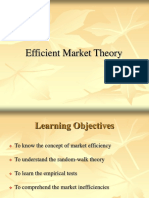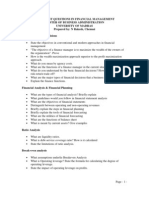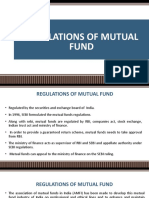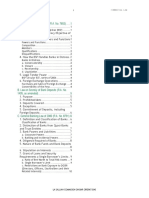0 ratings0% found this document useful (0 votes)
609 viewsLesson 5 Tax Planning With Reference To Capital Structure
This document discusses various tax concepts related to financial management decisions, including capital structure, dividends, accumulated profits, and tax planning related to dividends. It defines key terms like capital structure, accumulated profits, and deemed dividends. It provides examples to illustrate how interest expenses are tax deductible while dividend payments are not, and how raising funds through debt can increase returns for shareholders. The document also discusses how loans to shareholders could be considered deemed dividends based on certain conditions.
Uploaded by
kelvinCopyright
© © All Rights Reserved
Available Formats
Download as PPTX, PDF, TXT or read online on Scribd
0 ratings0% found this document useful (0 votes)
609 viewsLesson 5 Tax Planning With Reference To Capital Structure
This document discusses various tax concepts related to financial management decisions, including capital structure, dividends, accumulated profits, and tax planning related to dividends. It defines key terms like capital structure, accumulated profits, and deemed dividends. It provides examples to illustrate how interest expenses are tax deductible while dividend payments are not, and how raising funds through debt can increase returns for shareholders. The document also discusses how loans to shareholders could be considered deemed dividends based on certain conditions.
Uploaded by
kelvinCopyright
© © All Rights Reserved
Available Formats
Download as PPTX, PDF, TXT or read online on Scribd
You are on page 1/ 37
TAX PLANNING WITH
REFERENCE TO FINANCIAL Lesson 5
MANAGEMENT DECISION
LEARNING OBJECTIVES
By the end of the lesson the learner should be able to;
1) Understand the concept of Capital Structure
2) The Meaning of Dividend [Section 7)
3) Understand the concept of Accumulated Profits
4) The Tax Treatment of Dividend
5) Bonus Share
6) Tax Planning in Relation to Dividend Income
CAPITAL STRUCTURE
Management decision regarding capital structure is very important
because it effects the dividend payable to the shareholder as well as
profit after tax of a company.
Capital structure refers to the mix of sources from which funds required
for the business are raised.
The choice relating to raising of funds and planning the capital
structure of an undertaking would be between capital and borrowings
and the planning of the optimum debt-equity ratio.
From tax point of view expenses incurred on raising loans/debentures
and interest payable on loans is deductible in computing taxable
income of the assessee.
Any amount of interest paid, in respect of loan for acquisition of an
asset for extension of existing business capitalised in the books of
account or not for any period beginning from the date on which loan
was taken for acquisition of such asset till the date on which such asset
was first put to use, shall not be allowed as a deduction.
However, it will be added to the cost of the asset.
On the other hand, the expenses incurred on raising capital/share capital
and interest on capital/dividend on share capital is not deductible in
computing the taxable income of the assessee.
However, the following expenses in relation to capital are deductible :
1) If the assessee is a firm, the interest payable to partners on their
capital and loan capital, subject to a maximum of 12% p.a.
2) If the assessee is a Kenyan company and in connection with the
issue, of shares and debentures incurs expenses (being underwriting
commission, brokerage and charges for drafting, typing, printing and
advertisement of the prospectus) twenty percent of such expenses are
allowed for each of the five successive previous years beginning with
the previous year in which the business commences.
From this it may be concluded that the borrowings contribute to tax
saving resulting a higher rate of return on owner's equity.
But this does not hold good in every case.
If the rate of return on total capital is more than the rate of interest,
definitely the borrowing would increase the rate of return on owner's
equity.
Example 1: Y Ltd. wants to raise KES. 200,000 which is required to
meet the expansion of the business. It has three options I-issue of share
capital only II-KES. 160,000 though issue of share capital on KES.
40,000 loan from bank at 10% interest III-KES. 40,000 by issue of share
capital and KES. 160,000 through loan from bank 10% interest.
You are required to advise the management regarding the best option in
following cases.
Case I-Rate of Returns 25% Case II. Rate of Return - 10%, Case III -
Rate of return-8% and Rate of tax 30%.
SOLUTION
MANAGEMENT PLANNING
REGARDING CAPITAL STRUCTURE:
1. Where rate of return on investment is more than the rate of interest, it
will increase the rate of return of equity capital. However, the legal
requirements for raising capital through any means of finance cannot be
ignored.
2. The capital may be utilised for acquisition of non-depreciable assets
like land, goodwill, etc. and borrowed funds may be utilised to acquire
depreciable assets.
The interest on loans for the period 'after setting up of business' but
before the asset was put to use will be capitalised and a higher amount
of depreciation will be allowed.
3. If the gestation period in an industry is more it is better to use capital
rather than loans.
This interest payment will be carried forward as business loss which the
assessee may not be able to set-off within the prescribed period of eight
years.
On the other hand, the money-lenders have to pay tax on their interest
income.
4. If interest is payable outside Kenya tax must be deducted at source.
If tax has not been deducted at source, the amount paid as interest will
not be allowed as a deduction in computing business income.
5. The term 'interest' has been defined in section 2 of the Income Tax
Act, 'Interest' means interest payable in any manner in respect of any
amount borrowed or debt incurred and includes any service fee or other
charge in respect of the moneys borrowed or debt incurred or in respect
of any credit facility which has not been utilised.
Hence, not only interest but also service fee or other charge on loans,
whether utilised or not, should be claimed as revenue expenses in
computing the business income.
EXAMPLE 2:
MEANING OF DIVIDEND [SEC.7)
Section 7 gives the definition of "deemed dividend".
However, the definition laid down by section 7 is
inclusive and not exhaustive. If, therefore, a particular
distribution is not regarded as dividend within the
extended meaning of the expression in section 7 it may
still be dividend for the purpose of the Income-tax Act.
Under section 7 the following payments or distributions by a company to its
shareholders are deemed as dividends to the extent of accumulated profits of the
company:
A. any distribution entailing the release of company's assets
B. any distribution of debenture, debenture-stock, deposit certificates and bonus to
preference shareholders
C. distribution on liquidation of company
D. distribution on reduction of capital
E. any payment by way of loan or advance by a closely-held company to a
shareholder holding substantial interest provided the loan should not have been
made in the ordinary course of business and money-lending should not be a
substantial part of the company's business.
ACCUMULATED PROFITS
Any payment or distribution under the aforesaid
clauses is treated as dividend.
However, the payment or distribution under the
aforesaid clauses can be treated as dividend only
to the extent of accumulated profits of the
company.
“Accumulated profits" It includes:
1) In the case of a company, which is not in liquidation, it includes all
profits of a company up to the date of distribution or payment.
2) In the case of a company which is in liquidation, it includes all
profits of the company up to the date of liquidation. But Where, the
liquidation is consequent on the compulsory acquisition of a
company's undertaking by the Government or a Government
company, accumulated profits do not include any profits of the
company prior to the three successive years immediately preceding
the previous year in which such acquisition took place.
For instance, if compulsory acquisition takes place on March 31, 2016,
its accumulated profits will exclude profits accumulated up to March 31.
Notes:
1. Accumulated profits include all profits (accumulated or current) up to the date
of distribution or payment (or up to the date of liquidation in the case of
liquidation). In a number of cases it has been held that accumulated profits are
computed on the basis of commercial profits.
2. Under section 7, any distribution by a company of its accumulated profits
(whether capitalised or not) is dividend if it entails the release of company's
assets.
In other words, there are two conditions prescribed by this section
First, distribution should be from accumulated profits (not from capital) and
Secondly, such distribution must result in the release of the assets by the
company.
Distribution may be in the form of payment in cash or kind.
3. Under this section the following two distributions are treated as dividend
to the extent of accumulated profits (whether capitalised or not) of the
company :
a) distribution by a company to its shareholders (whether equity
shareholders or preference shareholders) of debentures, debenture-stock
or deposit certificates in any form, whether with or without interest; and
b) distribution by a company to its preference shareholders of bonus shares.
_
4. Any distribution made by a company to its shareholders on its liquidation
is treated as dividend to the extent to which such distribution is attributable
to the accumulated profits (whether capitalised or not) of the company
immediately before its liquidation.
Loan or advance:
Any loan or advance to a shareholder or concern is treated as
dividend in certain cases.
a) Loan or advance is given by a closely-held company.
b) Such loan is given to a registered shareholder.
c) The shareholder (getting the loan) beneficially holds 10 per
cent or more of equity shares in the company.
d) Such loan or advance is treated as dividend in the hands of
shareholder.
Important points:
1. Such loan or advance is treated as dividend to the extent of accumulated
profits (excluding capitalized profit).
2. Loan or advance for the above purpose may be given to a shareholder
directly or it may be given for the benefit of shareholder or on behalf of
shareholder.
3. "Concern" for this purpose may be a sole proprietor, firm, or a company.
4. A person shall be deemed to have a substantial interest in a concern, if he is
(at any time during the previous year), beneficially entitled to at least 12.5 per
cent of income of such concern (if such concern is a company, then he should
beneficially hold at least 12.5 per cent equity share capital of the company).
5. Where money-lending is a substantial part of the business
of the company, the above provisions are not applicable.
For this purpose, the factual position as it stands during
relevant previous year alone is supposed to be taken into
consideration to decide whether lending of money is
substantial part of business of concerned company.
6. If after giving loan or advance to a shareholder, the
company declares normal dividend and such dividend is set
off against outstanding loan/advance, the amount so set off
will not be treated as "dividend".
TAX TREATMENT OF
DIVIDEND
Non-Taxable Dividend/Exempt
a) Dividend received from an investment outside Kenya (foreign
dividend).
b) Dividend received by a resident company from another resident
company where it controls 12.5% or more of the share capital.
c) Dividends received by Insurance Company from its life assurance
Fund.
d) The issuance of debentures or redeemable shares for free or for part
payment in the care of a body corporate.
Points to Note
Dividends are taxable on the recipient in the year in which they are
received.
Dividend is subject to withholding tax of 15%. The net amount is paid
to the shareholders. However, if the dividend for any individual is less
than Shs.150, then no withholding tax is deducted.
The withholding tax on dividend 15% is considered as Final tax.
Meaning the dividend income of resident is not added to other income
of any person and there is no set-off of tax withheld at source.
In case of non-resident, the rate of withholding tax is 10%.
Classification of Dividends
Dividends are classified into two, namely; Qualifying dividend and Non-qualifying
dividend
Qualifying dividend
There are dividends which are subjected to withholding tax only i.e. withholding tax in this
case is a final tax.
The withholding tax rate is 5% on the gross amount for residents. The non-resident rate is
10% as final tax.
Are paid out by:
Private Companies
Public Companies
SACCOs (Savings and Credit Cooperative Societies
Examples of SACCOs are; {Harambee SACCO, Mwalimu SACCO, Magereza SACCO}
Non-Qualifying dividend
These are dividends paid out by Cooperative Societies other than
Sacco’s .e.g.
Kiambu Farmers Coop society
Ngong Women Coop society
Taveta Farmers’ Cooperative Societies
The Withholding tax rate is 15% which is not a final tax.
The Non-qualifying dividend will be aggregated with other incomes of
that person and taxed further and any withholding tax suffered will be
allowed as a set off tax.
BONUS SHARES
When a company issues shares to the existing shareholders in
lieu of dividends such shares are termed as 'bonus shares'.
By issue of bonus shares a company capitalises its profits and
widens the capital base.
Expenditure incurred on issue of bonus shares is capital
expenditure hence, not deducted in computing the income of
the company.
Where bonus shares are issued to the equity shareholders, the
value of the shares is not taxed as dividend distributed.
However, when redeemable preference shares are issued as bonus
shares, on their redemption, the amount shall be taxed as dividend
distributed.
When an equity shareholder sells the bonus shares the cost of
bonus shares is taken as zero.
Hence, the whole net consideration (consideration less selling
expenses if any) is treated as capital gains, as the case may be.
TAX PLANNING IN RELATION TO
DIVIDEND INCOME
1. A domestic company may issue bonus shares to its equity shareholders
in lieu of dividend in cash. By this method it can avoid the tax on
dividend distributed. However, it will increase tax liability of its
shareholders on transfer.
2. Payment made by a closely-held company to a shareholder who is the
beneficial owner of not less than 10% of the equity shares of the
company or on his behalf or for his benefit, is deemed to be dividends to
the extent of accumulated profits.
This deemed dividend is not exempt . Such a shareholder should not
take loan from the company or ask the company to make payment on
his behalf or for his benefit.
However, if it is not possible, he should reduce his shareholding to less
than 10% of equity share capital.
3. Similarly, a concern, in which the aforesaid shareholder has
substantial interest (entitled to not less than 12.5% of the income of the
concern or 12.5% voting right in the company), should not borrow from
the closely-held company. Otherwise, it will be taxed as deemed
dividend in the hands of the concern,
4. Where a loan in the hands of a shareholder or concern, has
been taxed as deemed dividend, such loan should not be repaid
to- the closely-held company.
It should be adjusted against the dividends declared by the
company in future.
The dividend declared in future and adjusted against the loan is
not treated as dividend declared.
Thus, the double taxation liability can be avoided.
EXAMPLE 3:
A domestic company possesses huge accumulated reserves. It
wants do distribute dividends of KES. 100 Million to its equity
shareholders. For this purpose it may issue 3 year 10%
redeemable preference shares or 3 year 10% redeemable
debentures. Keeping in view the following information suggest
to the company whether it should issue bonus shares or bonus
debentures so that the tax liability of the company and its
shareholders is reduced:
Assume Rate of tax on income of company and shareholder is
30% and Dividend Distribution Tax is 15%.
SOLUTION
QUESTIONS
From tax point of view which of the following would you
prefer:
(a) Issue of shares or issue of debentures
(b) Payment of dividend or issue of bonus hares
Give reasons for your answer from tax planning point of
view.
Question 2
P. Ltd., a domestic company, furnishes the following particulars of its
income and payments for the previous year 2016
KES.
Profits of business (computed) 500,000
Dividend from B. Ltd., a domestic company 200,000
Dividend from C Ltd., a foreign company 500,000
Dividend paid to shareholders of P Ltd. on 1.10-2015 400,000
Compute the total income and tax payable for A.Y. 2017
Question 5
P holds 12.5% shares carrying voting power in a
domestic company in which public are not substantially
interested. On 1st Jan., 2015, he obtained a loan of KES.
500,000 at 10% interest per annum from the company.
As on that date, the company had accumulated profits of
KES. 400,000.
Explain the tax implications of the transaction for P and
also for the company.
Question 6
A company has share capital of KES. ten million and is planning to invest an
additional fund of KES. 8,000,000 towards its expansion programme. Suggest the
best option from the following from tax planning point of view:
1) To issue share capital of KES. 8,000,000.
2) To borrow KES. 2,000,000@ 18% p.a. and to issue debentures of KES.
2,000,000@ 11% p.a. and the balance amount be collected by issuing shares in
the public.
3) To issue debentures for KES. 5,000,000 @ 11% p.a. and the balance be collected
by issuing shares in the public.
4) Rate of return is 30% before paying any interest and tax.
5) Rate of tax is 30%.
END Thank you
You might also like
- Chapter 10 Income From Business or Profession100% (1)Chapter 10 Income From Business or Profession14 pages
- Study Notes For NISM Series V - A: Mutual Fund Distributors Exam (Earlier - AMFI Exam)No ratings yetStudy Notes For NISM Series V - A: Mutual Fund Distributors Exam (Earlier - AMFI Exam)38 pages
- Sapm PPT 1 - Introduction To InvestmentNo ratings yetSapm PPT 1 - Introduction To Investment57 pages
- Economic Significance of Index MovementsNo ratings yetEconomic Significance of Index Movements10 pages
- CAclubindia News - Managerial Remuneration (In A Simple Way) PDFNo ratings yetCAclubindia News - Managerial Remuneration (In A Simple Way) PDF3 pages
- Tax Planing With Reference To Form of OrganizationNo ratings yetTax Planing With Reference To Form of Organization4 pages
- IBM Questions From Previous VTU Question PapersNo ratings yetIBM Questions From Previous VTU Question Papers8 pages
- Security Analysis & Portfolio Management Syllabus MBA III SemNo ratings yetSecurity Analysis & Portfolio Management Syllabus MBA III Sem1 page
- Evolution and Role of Financial Services Companies in0% (2)Evolution and Role of Financial Services Companies in11 pages
- 1845962535marketing Management C B Gupta N Rajan N0% (2)1845962535marketing Management C B Gupta N Rajan N17 pages
- Module-5 Merchant Banking: 1 Prof. Sainath, Ph.D. Dept of Management Studies, NHCENo ratings yetModule-5 Merchant Banking: 1 Prof. Sainath, Ph.D. Dept of Management Studies, NHCE66 pages
- CH 3 Institutional Support To International BusinessNo ratings yetCH 3 Institutional Support To International Business77 pages
- Gilt-Edged Securities in India by G-7 Sec-C PDFNo ratings yetGilt-Edged Securities in India by G-7 Sec-C PDF60 pages
- Industrial Policies RESOLUTION FROM 1948-1991: Presented BY:-Mandeep Kaur Mcom 1 Sem100% (1)Industrial Policies RESOLUTION FROM 1948-1991: Presented BY:-Mandeep Kaur Mcom 1 Sem34 pages
- Module 3 N.R Narayan Murthy Committee Report On CorporateNo ratings yetModule 3 N.R Narayan Murthy Committee Report On Corporate4 pages
- Banking Theory Law and Practice: Unit - I: Introduction To BankingNo ratings yetBanking Theory Law and Practice: Unit - I: Introduction To Banking4 pages
- Resource Planning in A Development BankNo ratings yetResource Planning in A Development Bank16 pages
- Security Analysis & Portfolio ManagementNo ratings yetSecurity Analysis & Portfolio Management45 pages
- 19P0310314 - Corporate Tax Planning - Meaning, Objectives and ScopeNo ratings yet19P0310314 - Corporate Tax Planning - Meaning, Objectives and Scope8 pages
- Current Cost Accounting (CCA) Technique - Inflation Accounting - Play Accounting0% (1)Current Cost Accounting (CCA) Technique - Inflation Accounting - Play Accounting2 pages
- Textbook of Urgent Care Management: Chapter 46, Urgent Care Center FinancingFrom EverandTextbook of Urgent Care Management: Chapter 46, Urgent Care Center FinancingNo ratings yet
- Facts:: Jerry Ong vs. Court of Appeals and Rural Bank of Olongapo, Inc. G.R. No. 112830, February 1, 1996100% (2)Facts:: Jerry Ong vs. Court of Appeals and Rural Bank of Olongapo, Inc. G.R. No. 112830, February 1, 19962 pages
- Company Law: M. S. RAMA RAO B.SC., M.A., M.LNo ratings yetCompany Law: M. S. RAMA RAO B.SC., M.A., M.L75 pages
- Enano-Bote Vs Alvarez, GR 223572, Nov. 10, 2020No ratings yetEnano-Bote Vs Alvarez, GR 223572, Nov. 10, 202021 pages
- 73) Consuelo Metal v. Planters Development WNo ratings yet73) Consuelo Metal v. Planters Development W2 pages
- Liquidators' Third Report On The State of Affairs Of: Cryptopia Limited (In Liquidation)No ratings yetLiquidators' Third Report On The State of Affairs Of: Cryptopia Limited (In Liquidation)15 pages
- Coral Part 1 - Notice of Motion and Founding Affidavit-Ocr100% (1)Coral Part 1 - Notice of Motion and Founding Affidavit-Ocr61 pages
- Chapter 17 Depletion of Mineral Resources Pbtaroy PDFNo ratings yetChapter 17 Depletion of Mineral Resources Pbtaroy PDF52 pages
- Advanced Accounting: Corporate Liquidations and ReorganizationsNo ratings yetAdvanced Accounting: Corporate Liquidations and Reorganizations43 pages
- Study Notes For NISM Series V - A: Mutual Fund Distributors Exam (Earlier - AMFI Exam)Study Notes For NISM Series V - A: Mutual Fund Distributors Exam (Earlier - AMFI Exam)
- CAclubindia News - Managerial Remuneration (In A Simple Way) PDFCAclubindia News - Managerial Remuneration (In A Simple Way) PDF
- Tax Planing With Reference To Form of OrganizationTax Planing With Reference To Form of Organization
- Security Analysis & Portfolio Management Syllabus MBA III SemSecurity Analysis & Portfolio Management Syllabus MBA III Sem
- Evolution and Role of Financial Services Companies inEvolution and Role of Financial Services Companies in
- 1845962535marketing Management C B Gupta N Rajan N1845962535marketing Management C B Gupta N Rajan N
- Module-5 Merchant Banking: 1 Prof. Sainath, Ph.D. Dept of Management Studies, NHCEModule-5 Merchant Banking: 1 Prof. Sainath, Ph.D. Dept of Management Studies, NHCE
- CH 3 Institutional Support To International BusinessCH 3 Institutional Support To International Business
- Industrial Policies RESOLUTION FROM 1948-1991: Presented BY:-Mandeep Kaur Mcom 1 SemIndustrial Policies RESOLUTION FROM 1948-1991: Presented BY:-Mandeep Kaur Mcom 1 Sem
- Module 3 N.R Narayan Murthy Committee Report On CorporateModule 3 N.R Narayan Murthy Committee Report On Corporate
- Banking Theory Law and Practice: Unit - I: Introduction To BankingBanking Theory Law and Practice: Unit - I: Introduction To Banking
- 19P0310314 - Corporate Tax Planning - Meaning, Objectives and Scope19P0310314 - Corporate Tax Planning - Meaning, Objectives and Scope
- Current Cost Accounting (CCA) Technique - Inflation Accounting - Play AccountingCurrent Cost Accounting (CCA) Technique - Inflation Accounting - Play Accounting
- Textbook of Urgent Care Management: Chapter 46, Urgent Care Center FinancingFrom EverandTextbook of Urgent Care Management: Chapter 46, Urgent Care Center Financing
- Facts:: Jerry Ong vs. Court of Appeals and Rural Bank of Olongapo, Inc. G.R. No. 112830, February 1, 1996Facts:: Jerry Ong vs. Court of Appeals and Rural Bank of Olongapo, Inc. G.R. No. 112830, February 1, 1996
- Liquidators' Third Report On The State of Affairs Of: Cryptopia Limited (In Liquidation)Liquidators' Third Report On The State of Affairs Of: Cryptopia Limited (In Liquidation)
- Coral Part 1 - Notice of Motion and Founding Affidavit-OcrCoral Part 1 - Notice of Motion and Founding Affidavit-Ocr
- Chapter 17 Depletion of Mineral Resources Pbtaroy PDFChapter 17 Depletion of Mineral Resources Pbtaroy PDF
- Advanced Accounting: Corporate Liquidations and ReorganizationsAdvanced Accounting: Corporate Liquidations and Reorganizations

























































































